Dirt Roads on the Navajo Nation
By Paulson Chaco, Susanna Mabery, and Rebecca Argo
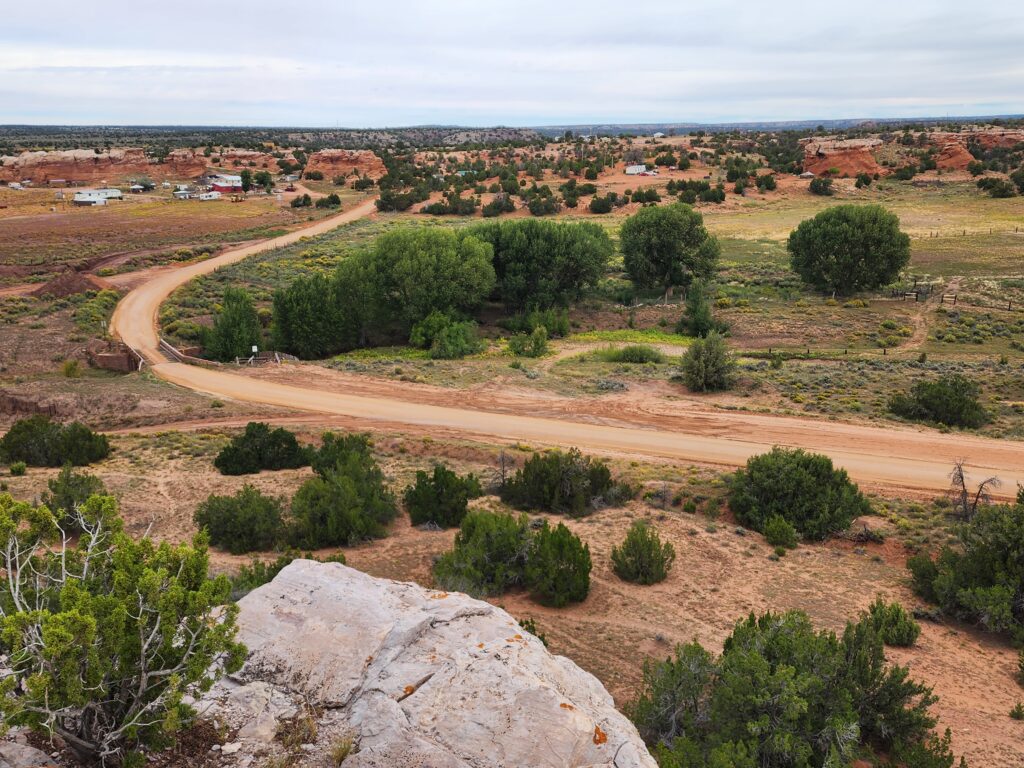
Introduction
Every mile of dirt road on the Navajo Nation tells a story of connection and challenge. When a road washes out, it can mean emergency medical situations, elders cut off from family, or children unable to reach school. These hardships are not new—they are woven into the history of the Nation’s infrastructure, shaped by decades of limited funding and the sheer scale of the land. The effort to pave and maintain these roads is rooted in community priorities and the shared goal of ensuring that every Navajo household can travel safely, no matter the weather.
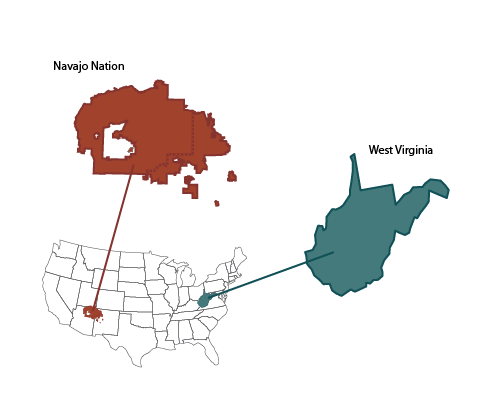
As the largest tribal entity in the United States, the Navajo Nation, encompasses more than 27,400 square miles across three states—Arizona, Utah, and New Mexico. As seen in the graphic to the left, the Nation is roughly the size of West Virginia and is divided into five agencies, each divided into chapters for a total of 110 chapters.
The Bureau of Indian Affairs (BIA) and the Navajo Nation own and maintain three types of roadway surfaces: paved, gravel, and dirt roads. Of the approximately 10,700 miles of roadway owned by the BIA and the Navajo Nation, roughly 85% are unpaved dirt roads, and 15% are paved roads.
Although dirt or gravel roads offer lower initial implementation costs, maintenance can become challenging and costly. Employing the correct strategies and thoughtful design considerations can contribute to the ongoing functionality of dirt or gravel roads.
Challenges
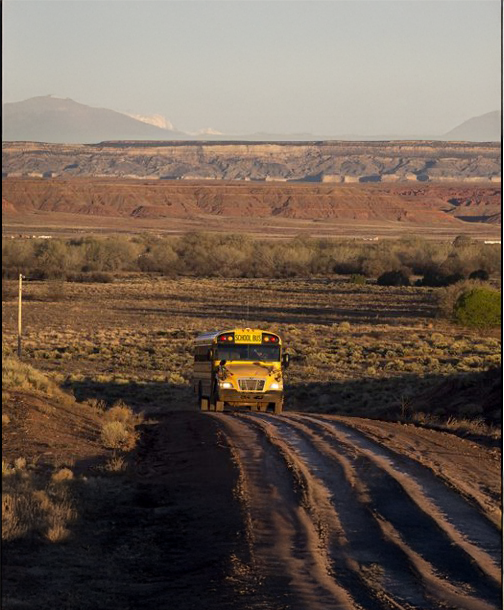
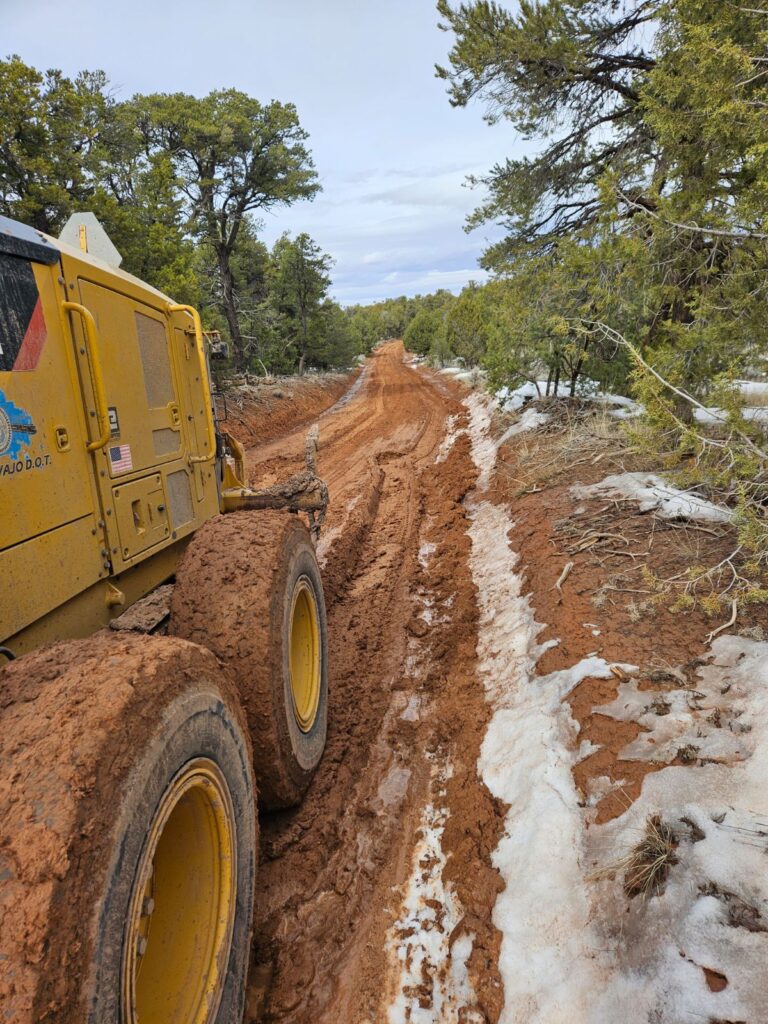
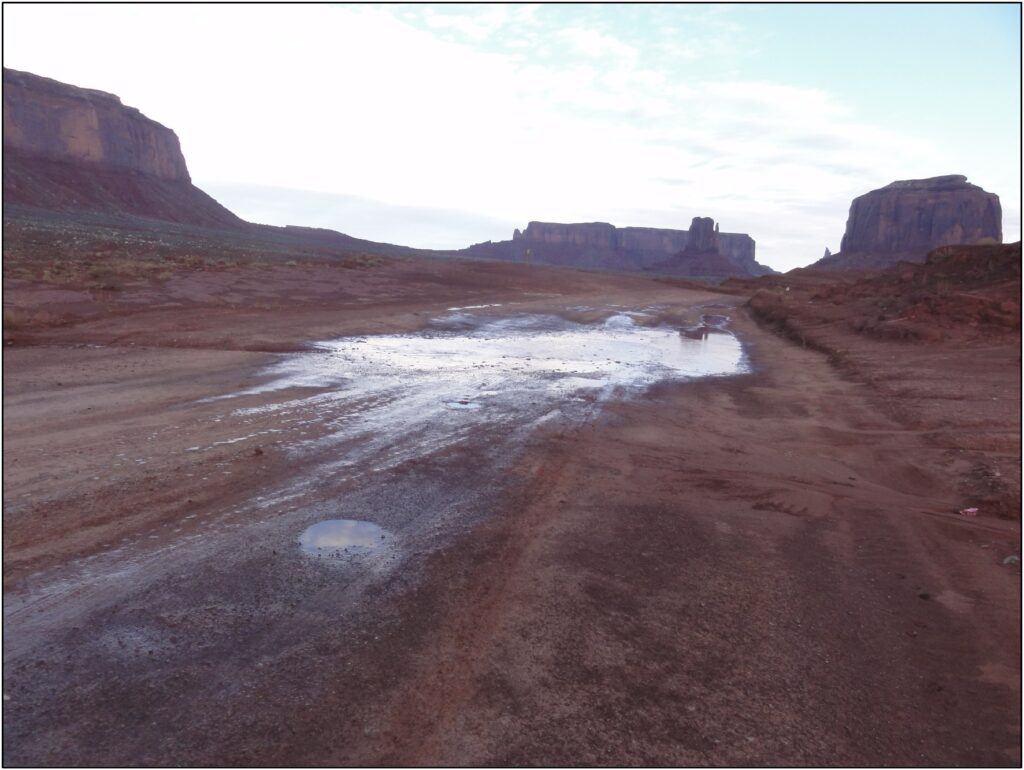
Maintaining dirt and gravel roads presents a significant resource challenge, requiring continual attention from maintenance staff. The Navajo Nation faces limitations in terms of available workers for road maintenance. This challenge is compounded by the remote locations of these roads, making the deployment of personnel and equipment a complex endeavor. Additionally, rising maintenance costs present yet another challenge to properly maintaining unpaved roads.
Unpaved roads, which are composed of dirt and/or gravel, encounter distinct difficulties compared to paved surfaces. Severe weather conditions, such as rain, can lead to flooding, which can cause rapid erosion, alter the road’s composition, and render it impassable. Unpaved roads are also more susceptible to the effects of wind. Within the Navajo Nation, these environmental adversities are widespread and frequently degrade the quality of unpaved roads. In addition, increased vehicle traffic on these roads further contributes to their deterioration. Furthermore, the safety of road users is at risk due to issues like corrugation (commonly referred to as washboarding), rutting, potholes, and sections of the road becoming muddy and impassable. As many Navajo households are located miles from paved roads, these impassable conditions can be devastating to their ability to access services in the community.
Incorporating drainage infrastructure like pipe culverts under the roadway or linear roadside ditches to convey stormwater runoff can provide some relief and enhance road functionality. However, these drainage components demand consistent maintenance to prevent them from becoming nonfunctional.
NDOT Prioritization and Project Process
The traffic volume a road experiences, often measured by the Average Annual Daily Traffic (AADT), is critical in determining road maintenance priorities. Ideally, these priority ratings should correspond with community preferences.
Annually, the Navajo Nation Division of Transportation (NDOT) undertakes extensive blading and dirt road maintenance activities spanning thousands of miles across the Navajo Nation’s chapters. The NDOT Planning Department collaborates with each chapter to establish a resolution identifying approximately 15 miles of routes within their community that require quarterly blading, known as
the 15-mile Regional Routes program. This information is subsequently relayed to the NDOT Department of Project Management, which oversees cultural and environmental compliance. In collaboration with the Department of Roads (DOR), the Planning Department formulates blading schedules for the agency’s road maintenance teams. These 15 miles of regional routes per chapter are vital for accessing essential services like education, employment, and healthcare.
Improvements should be prioritized based on data and performance metrics. For instance, the highest priority would be roadways with a high AADT and a designation as a chapter-defined regional route. In addition to traffic volumes, other considerations include the availability of alternative routes, whether the route is used as a school bus route, ease of emergency access in the area, and commercial vehicle usage. This priority ranking based on AADT is depicted below in Figure 1.
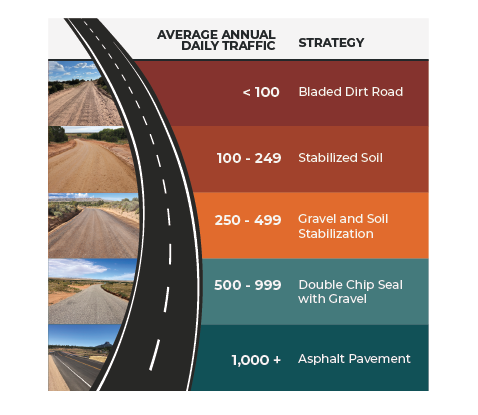
In addition, a roadway improvement project must support the goals of NDOT’s Long-Range Transportation Plan. These goals are defined as:
- Taking care of the system
- Enhancing existing partnerships and creating new partnerships
- Maximizing the effectiveness of transportation investments
- Improving safety
- Creating connections in the community
- Providing options for travel
- Promoting economic development
Another consideration for the roadway surface is the vehicle types traveling the roadway—for example, whether the road is primarily traveled by passenger cars or whether it sustains two-axle or three- to five-axle truck traffic. Other design conditions include the design life of the road, freeze/thaw conditions in the area, surrounding drainage features (or lack thereof), and the depth of ruts in the roadway.
The ultimate solution would be to pave the roadway with an appropriate asphalt concrete pavement section. However, most unpaved roads lack the AADT to justify a paved surface. Moreover, there are much higher construction costs associated with paving. For the most heavily traveled dirt roads across the Nation (with an AADT exceeding 1,000 vehicles), over $1.1 billion would be required to implement paving. Blading the roadway is the most budget-friendly dirt road improvement option, followed by grading and stabilizing the existing natural material. Laying down 4 or 6 inches of gravel (possibly with a chip seal) is a mid-budget alternative, followed by paving the roadway as the most costly alternative. Determining the best treatment for a given section of road is a collaborative effort that considers AADT, the route’s importance, and budget.
Throughout a roadway’s lifecycle, maintenance expenses must be considered. Typical maintenance activities include blading/leveling, grading, pothole repair, and maintenance of positive drainage. While paved roads require less maintenance in their initial 5 to 10 years, there comes a point when it becomes imperative. Improving and maintaining dirt roads provides greater cost efficiencies in the long run. The critical question is, what strategies are the most effective in enhancing the resilience of dirt or gravel roads while remaining manageable?
Solutions
Below are several best-practice solutions to improve dirt roads, making them safer and easier to travel on.
Solution #1: Effective Drainage
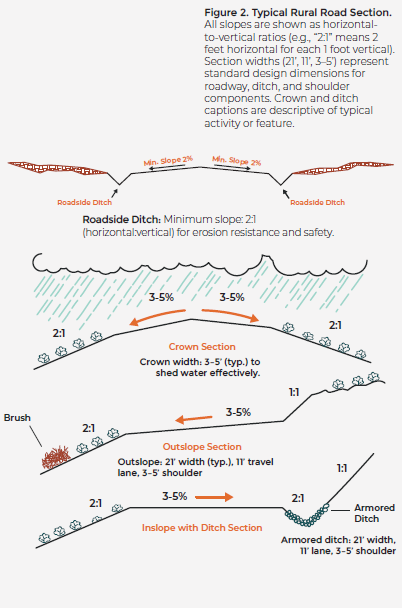
Controlling runoff and providing drainage solutions are critical first steps for long-term maintenance. Roadside ditches facilitate runoff from the road, adjacent slopes, and surrounding areas. Low-water crossings, diversions, or culverts running underneath the road can be designed to control water surging over the road. Performing maintenance to keep culverts clean and free of debris also improves drainage flow and helps with overall road maintenance.
Shaping and grading the roadway can also support proper drainage, as shown in Figure 2 to the right. A crowned surface in the middle of the road and sloped shoulders ensure that water naturally flows toward the edges. Instead of a crown, some roads will drain better if graded to one side. During drainage analysis and design, the team models the flow of water from various storm intensities through different methods and selects the best alternative based on the needs of the road segment.
The key to effective drainage hinges on working with nature rather than against it. Discovering the natural drainage patterns of the surrounding landscape and accommodating the water flow will provide a more sustainable solution. Options for accommodating water that needs to cross the roadway include low-water crossings, pipe culverts, box culverts, and bridges. Successfully addressing drainage issues on unpaved roads, such as diverting or slowing down the flow of water to prevent culverts from becoming washed out, is imperative.
Solution # 2: Blading
The road can be bladed to even out high and low spots and restore the driving surface. Regular blading plays a pivotal role in preserving the quality of the dirt road and promoting consistent material distribution. The process for blading a dirt road includes the following steps:
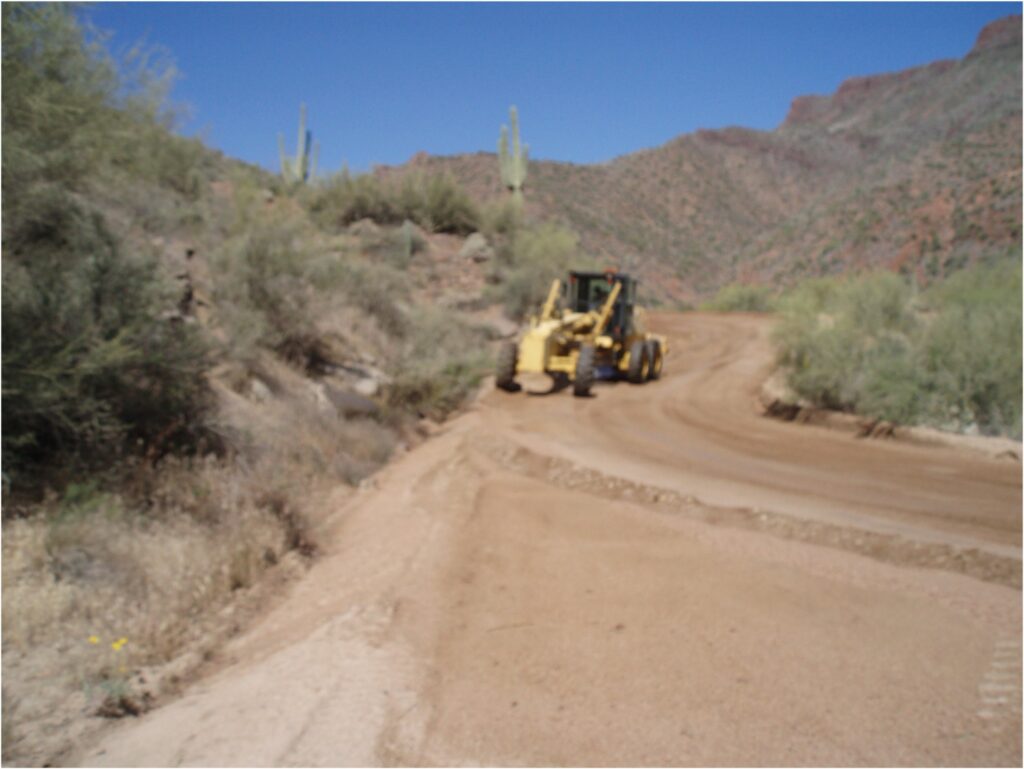
- Clean out roadside v-ditches
- Reestablish ditch lines
- Pull in the road edges
- Loosen the road surface
- Add moisture
- Rebuild the roadway prism shape
- Groom and finish the road
- Compact
Blading a gravel road involves the same steps as blading a dirt road. Gravel scattered along the side of the road or in the v-ditches should be moved back to the road and mixed with the surface gravel. Water should be added to ensure proper moisture content to reduce dust when blading. Adding water also helps to provide adequate compaction, which reduces washboarding and rutting of the roadway.
Solution #3: Soil Stabilization

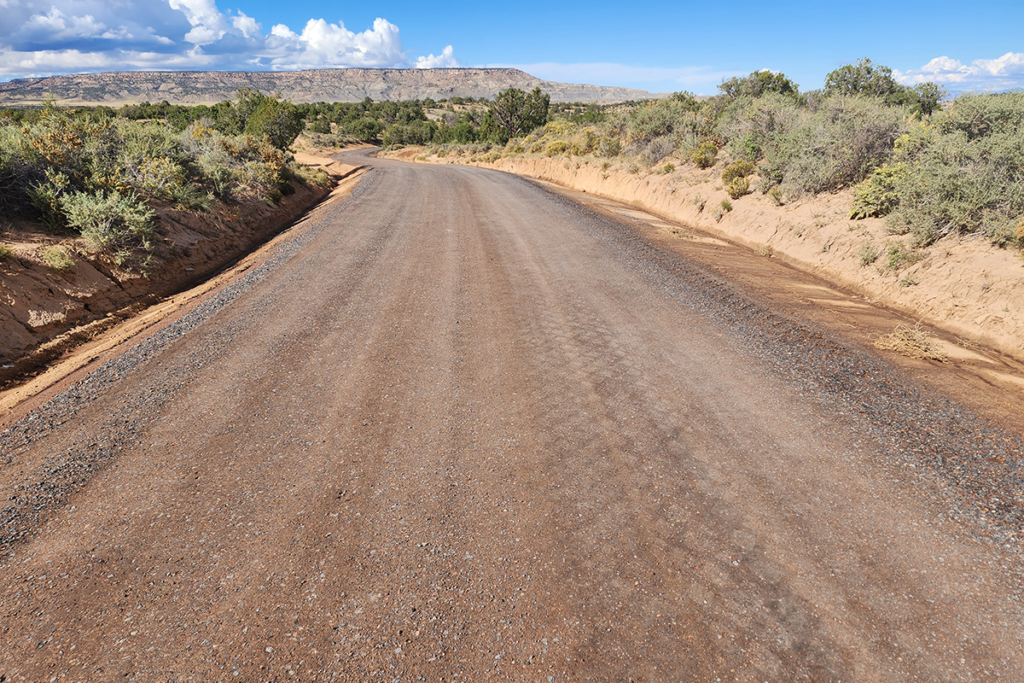
Chemical soil stabilization aims to mitigate dust, improve roadway conditions when wet, reduce tire ruts and potholes, and reduce maintenance costs.
Before beginning soil stabilization, monitoring and maintaining the roadway, especially after significant snowfall or rainfall, is recommended to measure relative humidity and temperature. Soil testing to classify the soil type is recommended for unpaved roads. The soil investigation should examine soil behavior such as expansion and contraction, collapsing, and particle migration. These steps provide insight into selecting the proper stabilizer product for optimal results.
A soil stabilization project includes preparing the subgrade; stabilizing the existing soil with an approved stabilization product; and applying a surface application to provide a solid, ridged surface or “crust” to protect the roadbed. The preferred roadway width is 24 feet.
Solution #4: Gravel Placement
Placing gravel on a dirt roadway provides additional improvements beyond stabilizing the surface. A well-graded mix of aggregate with various particle sizes allows for better interlocking to create a higher density and more stable surface treatment. Proper compaction will help mitigate washboarding and rutting in the roadway. The gravel should be tested within the prospective environment to ensure it will drain well. Maintaining the roadway shape and incorporating culverts and other drainage solutions will prevent water from pooling on the surface, extend the gravel roadway’s life, and reduce maintenance efforts.
In 2021 and 2022, NDOT partnered with Navajo County, Kayenta Peabody Mine, and various Navajo Nation chapters on the Red Dog Graveling project in the Central and Western Agencies. Using gravel from the Peabody Mine, the project provided graveled, all-weather roads on key routes within the Navajo Nation to alleviate the effects of snowfall and summer rains on these dirt roads. The project required a visual inspection of roads to prioritize the routes, as well as the completion of all required environmental clearances. Placing gravel on these strategic routes has enhanced accessibility to the Navajo community during adverse weather conditions.
Funding
The Navajo Nation receives annual Tribal Transportation Improvement Program (TTIP) funding designated for operations and planning, which can include a wide variety of improvements such as incorporating roadway safety enhancements or adding culverts to pass drainage washes under the road. In addition, the tribe collects funding from the fuel excise tax (FET), which helps fund local road improvement projects and the general fund. The BIA also receives annual funding from the U.S. Department of the Interior to maintain BIA-designated roadways, though this funding is insufficient to fund dirt road maintenance fully. Despite these funding sources, more funds are needed to support the Navajo Nation’s vast number of unpaved roads.
NDOT reserves a portion of its Federal Highway Administration (FHWA) funding each year to perform maintenance work on the 15-mile Regional Routes program. In addition, NDOT performs blading and other dirt road maintenance using their annual share of the Navajo Nation Road Fund (funded by the tribe’s FET). Throughout the year, agency planners and road maintenance crews continuously communicate with chapter leadership and communities for updates on the road maintenance program and schedule.
Another potential funding source for roadways within New Mexico is the Capital Outlay Program, which allocates bonds or oil revenues to provide funding for particular road projects. The funds allocated to the Navajo Nation depend on the project scope between the State of New Mexico and the Navajo Nation.
Prioritizing drainage as a primary focus for funding proves to be a successful strategy to preserve unpaved roads. Enhancing culverts, incorporating ditches, and regrading the roadway stand out as viable drainage solutions.
Phasing Strategies
Due to the vast quantity of dirt roads within its transportation network, NDOT has implemented a three-phased strategy to maintain and improve dirt roads, as shown below in Figure 3. Phase 1 focuses on grading and drainage improvements, while Phase 2 provides surface treatment solutions, and Phase 3 provides paving as the ultimate roadway improvement.
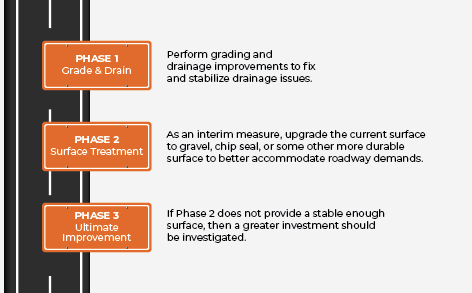
If the daily traffic on the dirt or gravel road surpasses the AADT limit set for its current road surface, an analysis should be conducted to determine the feasibility of a different surface treatment. Lower-cost measures to improve the resiliency of the dirt road should be implemented where feasible, such as increased drainage mitigation, chemical stabilization, and routine blading. Exploring alternative funding sources, such as seeking federal grants, could offer opportunities to address the extensive network of dirt roads within the Navajo Nation.
Conclusion
Perhaps the most significant challenges facing dirt road improvement and maintenance on Navajo lands are the lack of funding and the remote areas connected by these roads. The key priority is to find the best solutions with the available funding. Another goal is to improve the drainage infrastructure on dirt roads, which lessens the required maintenance to keep the road safe
and operational.
TAKE ACTION
Tribal members can take action to advocate for road improvements in their communities by expressing concerns to their chapters, which identify the need for the project and take these concerns to the Planning Department.
SEEK FUNDING
The Planning Department collaborates with the chapter to seek grant funding or other state funding to address these concerns, and the NDOT team evaluates the available phasing strategies and roadway treatments. An increase in federal funding would greatly help the Navajo Nation improve and maintain its roads.
PRIORITIZE ROADS
It is important to note that although members can suggest priorities for road improvements, the actual improvements depend on many factors, such as the AADT, the route’s importance, and the budget.
For the Navajo Nation, roads are life—they connect tribal members to essential services in and near their communities, such as schools, grocery stores, places of employment, healthcare, and community resources. Improving and maintaining dirt roads is essential to maintaining the health and well-being of the Navajo Nation.

